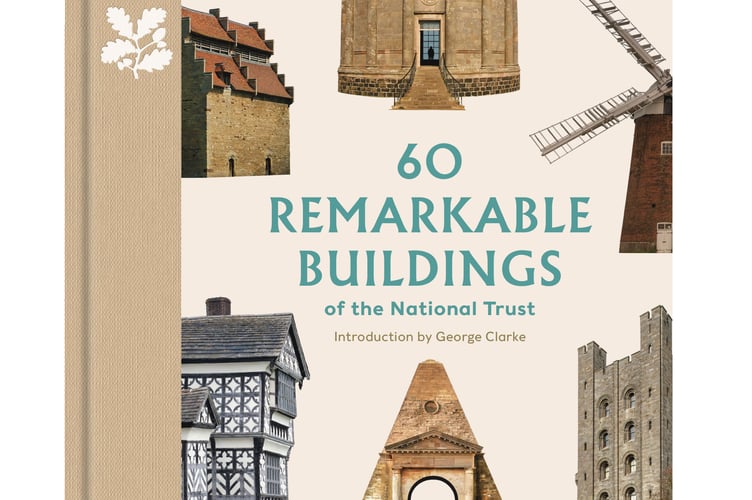Pembrokeshire’s Treleddyd Fawr is featured in a new National Trust book, alongside four other buildings from across Wales.
They are Tredegar House’s magnificent stables; Powis Castle’s incredible Baroque Terraces, Powys; Conwy Suspension Bridge, Conwy; and Penrhyn Castle, Bangor.
The latest book from the National Trust, 60 Remarkable Buildings of the National Trust, brings together an astonishing collection of built structures that includes urban and rural, industrial and domestic buildings, places of spirituality and faith, life and death.

While previous books about National Trust properties tended to focus on their historic owners and the collections they acquired, this new book puts the buildings themselves firmly in the spotlight.
The book provides fresh insights into the work of the UK’s ground-breaking historic architects and the people who commissioned them. The buildings showcase the richly varied styles, materials and techniques found across England, Wales and Northern Ireland, and embody skills, traditions and knowledge passed down through generations.
Written by Dr Elizabeth Green, Senior National Curator for Wales and Architectural History for the National Trust and with an introduction by popular TV presenter, architect and life member of the National Trust, George Clarke, the book includes five buildings from across the length and breadth of Wales and spanning centuries of the country’s history.
The magnificent stables at Tredegar House in Newport reflect the importance and status William Morgan placed on his equestrian skills. Constructed during the Restoration rebuild of Tredegar in the mid-late 1660s, the stables are located at the front of the house and feature elaborate carvings over the entrance passage, including two suits of armour, cannon, drums and a Classical Roman bust. Pages 74–5.
Built during the Industrial Revolution, Thomas Telford’s suspension bridge across the Conwy Estuary is, along with its nearby sister crossing the Menai Strait, one of the world’s first two suspension bridges, both opened in 1826. Conwy Bridge spans 99.4 metres and the suspended road deck is carried by eight iron chains, slung from 13-metre-high castellated towers built of Penmon limestone. Pages 136–9.
The majority of buildings in the National Trust’s care are vernacular – the cottages, barns and farmsteads that pepper our rural landscapes and tell of past ways of life. Treleddyd Fawr in Pembrokeshire is a former farmhouse of rubble stone which underwent an 18-month restoration thanks to the Trust’s Neptune coastline campaign. The whole building – including the slate roof - is coated in layers of limewash to repel the prevailing wet south-westerly winds. Pages 82–3.

Buildings are also a record of changing ways of life, social division and political and religious struggles. Between periods of imprisonment and exile during the tumult of the 17th century, William Herbert, 3rd Baron Powis carried out considerable improvements to Powis Castle and began work creating one of the finest Baroque Italian terraced gardens in Europe. Powis’ staggeringly steep terracing cleverly takes advantage of the red sandstone outcrop on which the castle is built. The cascading arcades are among Powis’ great symbols of status. Pages 78-81.
Examining Penrhyn Castle, Bangor, the book explores how the bones of a fine medieval hall house are still embedded in castle’s core, which was built on colonial and industrial foundations and a long history of sugar and slate fortunes. Around 1820, Dawkins-Pennant commissioned the architect Thomas Hopper to design a new house, resulting in the massive Neo-Norman castle of unusual Romanesque style. The castle walls are clad in Penmon limestone, with a vast roof slated from Penrhyn Quarry. Pages 146-9.
Rhian Sula, General Manager for Pembrokeshire, National Trust Cymru, said:“I’m so pleased to see Treleddyd Fawr featured in 60 Remarkable Buildings of the National Trust and 60 o Adeiladau Rhyfeddol yr Ymddiriedolaeth Genedlaethol, alongside so many other astonishing places across England, Wales and Northern Ireland. The book shows clearly how buildings contribute to our understanding of social and political history, and Treleddyd Fawr is crucial in telling the unique story of our area and communities.”
Today, the Trust’s focus is on addressing the challenges presented to our buildings, landscapes and habitats by climate change, and on ensuring that the places in its care contribute to the wellbeing of all.
George Clarke notes in his introduction:“I absolutely love the National Trust and that love grew to another level when I decided at the age of 12 to become an architect. So, this introduction is the perfect opportunity for me to personally thank the National Trust for bringing so much joy to my life. It is a fantastic organisation and without the Trust we would have lost so much of our architectural heritage and picturesque landscapes, so it is vital we do everything we can to support it.”
The book includes many other structures that may not always be what the reader expects.
In 1912, Cushendun, a scattered hamlet of houses facing a small harbour on the Antrim coast of Northern Ireland, was transformed by Welsh architect Clough Williams-Ellis in a late flourishing of Arts and Crafts style. The book refers to the hamlet as ‘Portmeirion’s Irish cousin’. Pages 180-1.
Horton Court in Gloucestershire is the oldest inhabited house in the Trust’s care, with parts of the building dating back to 1185. The bulk of the house was added c.1521 for William Knight, who was ambassador to kings Henry VII and VIII, attended the Field of the Cloth of Gold, and negotiated with the Pope to secure the divorce between Henry VIII and Catherine of Aragon. Pages 22-25.
Following the end of the First World War, a housebuilding boom took place in England. Four million new houses were built and suburbs were born. Mendips, in Liverpool is a typical semi-detached home, reflecting this boom, but it was home to an extraordinary individual, John Lennon. Pages 182–5.
60 Remarkable Buildings of the National Trust and the Welsh-language edition, 60 o Adeiladau Rhyfeddol yr Ymddiriedolaeth Genedlaethol, will be available to purchase from September 7 on the National Trust website, from National Trust shops and other online and high-street retailers.




